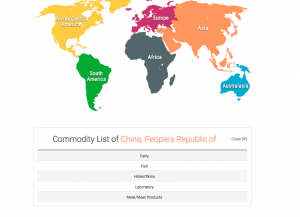Now is an ideal time to take stock and make plans to increase in your exports in 2020. It seems likely that we will leave the EU on 31st January 2020 and enter the transition period, due to end on 31st December 2020. With the uncertainty continuing over the future trade agreement post Brexit, and the potential need for export health certificates, many companies are looking outside the EU to grow their exports.
Our top tips, listed below, are designed to act as a health check for your exports, as well as to inspire you to look for new opportunities to continue to grow your exports, sales and profits.
Tip 1: Find new target markets
Even if you’re on a winning streak, there is never time to rest on your laurels. Finding a new export market isn’t as difficult and time consuming as you may think. In our previous ‘Where are the biggest markets and opportunities?’ blog post, we linked to DEFRA’s UK Food and Drink International Action Plan, which is aiming to increase food exports by an additional £2.9 billion, to markets such as Australia & New Zealand, Mexico and Latin America, India, USA and Canada, China, Japan and the UAE & Gulf region.
Tip 2: Use our free Export Health Certificate tool and map
By using our free Export Health Certificate tool or Interactive export map, you can quickly discover which products you can ship to which countries, and which EHC you will need to start exporting. This is regularly updated with details of new or changed EHC, which are also tweeted.
Tip 3: Check your import permits
Checking essential paperwork, such as your import permits, is an essential task as we go into a new year. Double check that your import permits are in date and cover your current product, and check to see if anything needs amending to cover any future products which are in development, or ready to export.
Tip 4: Check that you are on the current version of the Export Health Certificate
Some EHC are updated regularly, and older versions can get rejected, costing you time and money. If you’re in doubt, contact us and we can arrange an audit of your EHC. Australia for example, had 4 changes to the dairy EHC 6969 in one year! Disease outbreaks (eg avian flu) can also affect the availability of EHC.
Tip 5: Double check your Manufacturer declarations (Mandecs)
As well as checking your EHC are up to date, now is also a great time to double check that your Mandecs are still up to date – and also the wording is in the required correct format. As well as your Mandecs, it’s also a good time to check that APHA have a list of approved signatories, that details of your suppliers and countries of origin are up to date, and that the heat treatment/processing/HACCP analysis information is correct.
Tip 6: Incoterms
Do you know your EXW from your DDP and your FCA from your DAP? International Chambers of Commerce have produced the 2020 version of Incoterms, so it is a great time to have a little refresher and update your knowledge. There are some significant changes. Take time to think about where the risk transfers, and if you are using the correct incoterm and version. A little work now will save a lot of time in the future.
Tip 7: Network, Network, Network
Never underestimate the power of networking. Many organisations, such as the local Chamber of Commerce, Department for International Trade, and the Food and Drink Exporters’ Association often hold regular meetings and networking opportunities. These types of events are great opportunities to meet new people, and to discover new business opportunities, so now is a great time to look for forthcoming events and get a networking plan in place.
Tip 8: Don’t panic about Brexit!
Whether you are celebrating or commiserating, it seems that the political ‘stalemate’ has been broken by the general election and it is likely that we will leave the EU on 31st January 2020. We will then enter the transition period (until 31st December 2020) where the export requirements and documentation will remain unchanged, so we will continue as normal during this time.
During this time, a free trade agreement will need to be negotiated, or the transition period extended or a ‘no-deal’ situation will arise. Until we get further details of this, it is impossible to predict what the outcome will be. However, other countries that have FTAs with the EU do still require EHC for many animal derived products so it is very likely that there will be a requirement for EHC and extra documentation for export from UK to EU (and potentially to NI if destined for onward shipment).
It is well worth lobbying your trade association, MP and industry bodies such as FDF and FDEA to express any concerns/difficulties this may cause – to see if these can be taken into account or any exemptions or bulk certification processes can be adopted.
With this in mind, we refer you back to Tip 1, which is to find a new target market outside of the EU. The USA and China are key target markets at the moment, but there are opportunities around the world, so if you’re looking to re-energise your exporting journey and you’d like to take advantage of our substantial experience and network of contacts, now is a great time to get in touch with us and we’ll be more than happy to help.
Witten by Andrew Iveson on and tagged in brexit, Export, food, new year,



